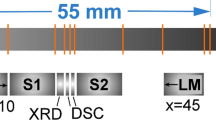Abstract
Interest in finding binary alloys that can form bulk metallic glasses has stimulated recent work on the Cu-Zr system, which is known to show glass formation over a wide composition range. This work focuses on copper mold casting of Cu50Zr50 (at.%), and it is shown that fully amorphous rods up to 2-mm diameter can be obtained. The primary intermetallic phase competing with glass formation on cooling is identified, and the glass-forming ability is interpreted in terms of a metastable eutectic involving this phase. Minor additions of aluminum increase the glass-forming ability: with addition of 4 at.% Al to Cu50Zr50, rods of at least 5-mm diameter can be cast fully amorphous. The improvement of glass-forming ability is related to suppression of the primary intermetallic phase.
Similar content being viewed by others
References
R. Ray, B.C. Giessen and N.J. Grant: Formation of Cu-Zr metallic glasses. Scripta Metall. 2, 359 (1968).
D. Turnbull: Under what conditions can a glass be formed? Contemp. Phys. 10, 473 (1969).
W.L. Johnson: Thermodynamic and kinetic aspects of the crystal to glass transformation in metallic materials. Prog. Mater. Sci. 30, 81 (1986).
A.L. Greer: Confusion by design. Nature 366, 303 (1993).
A.L. Greer: Metallic glasses. Science 267, 1947 (1995).
R.W. Cahn and A.L. Greer: Metastable states of alloys, in Physical Metallurgy, revised and enhanced edition, edited by R.W. Cahn and P. Haasen (Elsevier Sciences BV, Amsterdam, The Netherlands, 1996), Chap. 19.
A. Inoue: Stabilization of metallic supercooled liquid and bulk amorphous alloys. Acta Mater. 48, 279 (2000).
T. Egami and Y. Waseda: Atomic size effect on the formability of metallic glasses. J. Non-Cryst. Solids 64, 113 (1984).
D.B. Miracle, W.S. Sanders and O.N. Senkov: The influence of efficient atomic packing on the constitution of metallic glasses. Philos. Mag. 83, 2409 (2003).
A.D. Le Claire: Interdiffusion between Cu and Zr. J. Nucl. Mater. 69-70, 70 (1978).
F.R. Boer, R. Boom, W.C.M. Matterns, A.R. Miedema and A.K. Niessen: Cohesion in Metals (North-Holland, Amsterdam, The Netherlands, 1988).
E. Hellstern and L. Schultz: Amorphization of transition metal Zr alloys by mechanical alloying. Appl. Phys. Lett. 48, 124 (1986).
M. Atzmon, J.R. Verhoeven, E.D. Gibson and W.L. Johnson: Formation and growth of amorphous phases by solid-state reaction in elemental composites prepared by cold working. Appl. Phys. Lett. 45, 1052 (1984).
D. Xu, B. Lohwongwatana, G. Duan, W.L. Johnson and C. Garland: Bulk metallic glass formation in binary Cu-rich alloy series-Cu100-xZrx(x = 34, 36, 38.2, 40 at.%) and mechanical properties of bulk Cu64Zr36 glass. Acta Mater. 52, 2621 (2004).
D. Xu, G. Duan and W.L. Johnson: Unusual glass-forming ability of bulk amorphous alloys based on ordinary metal copper. Phys. Rev. Lett. 92, 245504 (2004).
A. Inoue and W. Zhang: Formation, thermal stability and mechanical properties of Cu-Zr and Cu-Hf binary glassy alloy rods. Mater. Trans. 45, 584 (2004).
D. Wang, Y. Li, B.B. Sun, M.L. Sui, K. Lu and E. Ma: Bulk metallic glass formation in the binary Cu-Zr system. Appl. Phys. Lett. 84, 4029 (2004).
M.B. Tang, D.Q. Zhao, M.X. Pan and W.H. Wang: Binary Cu-Zr bulk metallic glasses. Chin. Phys. Lett. 21, 901 (2004).
A. Inoue and W. Zhang: Formation, thermal stability and mechanical properties of Cu-Zr-Al bulk glassy alloys. Mater. Trans. 43, 2921 (2002).
C.A. Angell: Formation of glasses from liquids and biopolymers. Science 267, 1924 (1995).
D.N. Perera: Compilation of the fragility parameters for several glass-forming metallic alloys. J. Phys. Condens. Matter 11, 3807 (1999).
J.M. Borrego, A. Conde, S. Roth and J. Eckert: Glass-forming ability and soft magnetic properties of FeCoSiAlGaPCB amorphous alloys. J. Appl. Phys. 92, 2073 (2002).
Z.F. Zhao and W.H. Wang: A highly glass-forming alloy with very low glass transition temperature. Appl. Phys. Lett. 82, 4699 (2003).
X.H. Lin and W.L. Johnson: Formation of Ti-Zr-Cu-Ni bulk metallic glasses. J. Appl. Phys. 78, 6514 (1995).
Z.P. Lu, H. Tan, Y. Li and S.C. Ng: The correlation between reduced glass transition temperature and glass forming ability of bulk metallic glasses. Scripta Mater. 42, 667 (2000).
K.J. Zeng, M. Hämäläinen and H.L. Lukas: Phase diagram of Cu-Zr alloy. J. Phase Equilibria 15, 577 (1994).
Á. Révész, A. Concustell, L.K. Varga, S. Suriñach and M.D. Baró: Influence of the wheel speed on the thermal behaviour of Cu60Zr20Ti20 alloys. Mater. Sci. Eng. A 375-377, 776 (2004).
T.P. Weihs, T.W. Barbee and M.A. Wall: Hardness, ductility, and thermal processing of Cu/Zr, and Cu/Cu-Zr nanoscale multilayer foils. Acta Mater. 45, 2307 (1997).
R. Arroyave, T.W. Eagar and L. Kaufman: Thermodynamic assessment of the Cu-Ti-Zr system. J. Alloys Compd. 351, 158 (2003).
R.J. Highmore and A.L. Greer: Eutectics and the formation of amorphous alloys. Nature 339, 363 (1989).
S. Bossuyt: Spatial localization of the nucleation rate and formation of inhomogeneous nanocrystalline dispersions in deeply undercooled glass forming liquids. Scripta Mater. 44, 2781 (2001).
S. Bossuyt and A.L. Greer: Effects of positive feedback on crystallization kinetics and recalescence, in Amorphous and Nanocrystalline Metals, edited by R. Busch, T.C. Hufnagel, J. Eckert, A. Inoue, W.L. Johnson, and A.R. Yavari (Mater. Res. Soc. Symp. Proc. 806, Warrendale, PA, 2004), p. 15.
Z.P. Lu and C.T. Liu: Role of minor alloying additions in formation of bulk metallic glasses: A Review. J. Mater. Sci. 39, 3965 (2004).
W.H. Wang, Z. Bian, P. Wen, Y. Zhang, M.X. Pan and D.Q. Zhao: Role of addition in formation and properties of Zr-based bulk metallic glasses. Intermetallics 10, 1249 (2002).
Author information
Authors and Affiliations
Corresponding author
Rights and permissions
About this article
Cite this article
Wang, W.H., Lewandowski, J.J. & Greer, A.L. Understanding the Glass-forming Ability of Cu50Zr50 Alloys in Terms of a Metastable Eutectic. Journal of Materials Research 20, 2307–2313 (2005). https://doi.org/10.1557/jmr.2005.0302
Received:
Accepted:
Published:
Issue Date:
DOI: https://doi.org/10.1557/jmr.2005.0302




